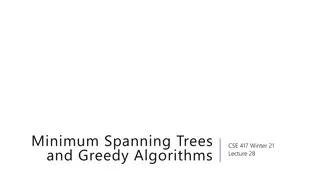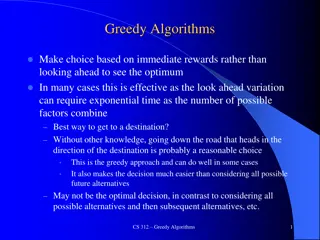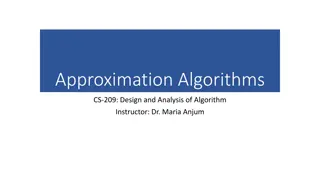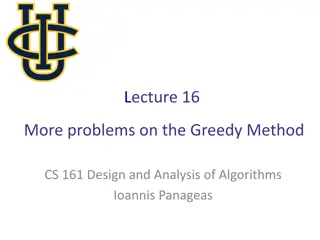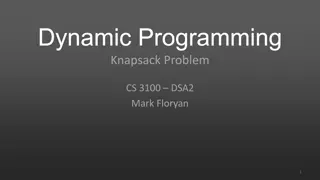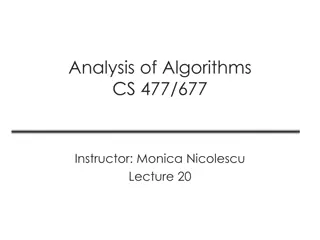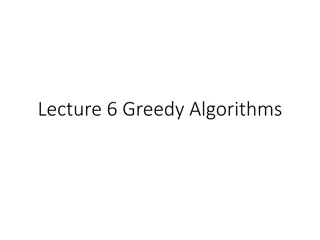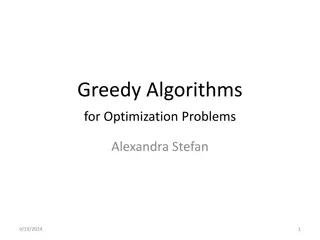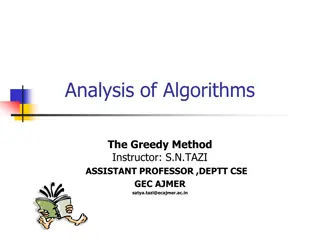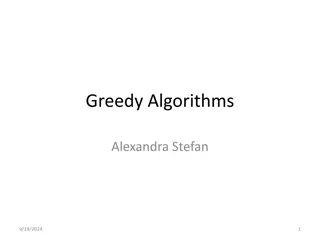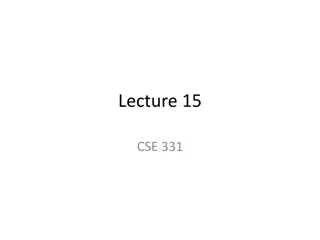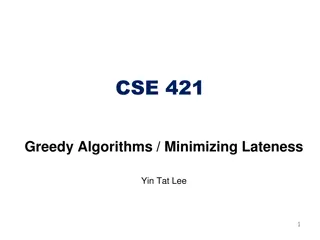Greedy Algorithms in Optimization Problems
Greedy algorithms are efficient approaches for solving optimization problems by making the best choice at each step. This method is applied in various scenarios such as finding optimal routes, encoding messages, and minimizing resource usage. One example is the Greedy Change-Making Algorithm for making change with U.S. coins, where the algorithm selects the highest-value coin without exceeding the remaining amount. The optimality of such algorithms can be proven by analyzing the possible coin combinations. These algorithms offer practical solutions for minimizing or maximizing parameters over all inputs.
Download Presentation

Please find below an Image/Link to download the presentation.
The content on the website is provided AS IS for your information and personal use only. It may not be sold, licensed, or shared on other websites without obtaining consent from the author.If you encounter any issues during the download, it is possible that the publisher has removed the file from their server.
You are allowed to download the files provided on this website for personal or commercial use, subject to the condition that they are used lawfully. All files are the property of their respective owners.
The content on the website is provided AS IS for your information and personal use only. It may not be sold, licensed, or shared on other websites without obtaining consent from the author.
E N D
Presentation Transcript
Greedy Algorithms Optimization problems minimize or maximize some parameter over all possible inputs. Among the many optimization problems we will study are: Finding a route between two cities with the smallest total mileage. Determining how to encode messages using the fewest possible bits. Finding the fiber links between network nodes using the least amount of fiber. Optimization problems can often be solved using a greedy algorithm, which makes the best choice at each step. Making the best choice at each step does not necessarily produce an optimal solution to the overall problem, but in many instances, it does. After specifying what the best choice at each step is, we try to prove that this approach always produces an optimal solution, or find a counterexample to show that it does not.
Greedy Algorithms: Making Change Example: Design a greedy algorithm for making change (in U.S. money) of n cents with the following coins: quarters (25 cents), dimes (10 cents), nickels (5 cents), and pennies (1 cent) , using the least total number of coins. Idea: At each step choose the coin with the largest possible value that does not exceed the amount of change left. 1. If n = 67 cents, first choose a quarter leaving 67 25 = 42 cents. Then choose another quarter leaving 42 25 = 17 cents 2. Then choose 1 dime, leaving 17 10 = 7 cents. 3. Choose 1 nickel, leaving 7 5 = 2 cents. 4. Choose a penny, leaving one cent. Choose another penny leaving 0 cents.
Greedy Change-Making Algorithm Solution: Greedy change-making algorithm for n cents. The algorithm works with any coin denominations c1, c2, ,cr. procedure change(c1, c2, , cr: values of coins, where c1> c2> > cr n:a positive integer) for i := 1 to r di:= 0 [di counts the coins of denomination ci] whilen ci di := di + 1 [add a coin of denomination ci] n=n -ci [di counts the coins ci] For the example of U.S. currency, we may have quarters, dimes, nickels and pennies, with c1= 25, c2= 10, c3= 5, and c4= 1.
Proving Optimality for U.S. Coins Show that the change making algorithm for U.S. coins is optimal. Lemma 1 1: If n is a positive integer, then n cents in change using quarters, dimes, nickels, and pennies, using the fewest coins possible has at most 2 dimes, 1 nickel, 4 pennies, and cannot have 2 dimes and a nickel. The total amount of change in dimes, nickels, and pennies must not exceed 24 cents. Proof: By contradiction If we had 3 dimes, we could replace them with a quarter and a nickel. If we had 2 nickels, we could replace them with 1 dime. If we had 5 pennies, we could replace them with a nickel. If we had 2 dimes and 1 nickel, we could replace them with a quarter. The allowable combinations, have a maximum value of 24 cents; 2 dimes and 4 pennies.
Proving Optimality for U.S. Coins Theorem: The greedy change-making algorithm for U.S. coins produces change using the fewest coins possible. Proof: By contradiction. 1. Assume there is a positive integer n such that change can be made for n cents using quarters, dimes, nickels, and pennies, with a fewer total number of coins than given by the algorithm. 2. Then, q q where q is the number of quarters used in this optimal way and q is the number of quarters in the greedy algorithm s solution. But this is not possible by Lemma 1, since the value of the coins other than quarters can not be greater than 24 cents. 3. Similarly, by Lemma 1, the two algorithms must have the same number of dimes, nickels, and quarters.
Greedy Change-Making Algorithm Optimality depends on the denominations available. For U.S. coins, optimality still holds if we add half dollar coins (50 cents) and dollar coins (100 cents). But if we allow only quarters (25 cents), dimes (10 cents), and pennies (1 cent), the algorithm no longer produces the minimum number of coins. Consider the example of 31 cents. The optimal number of coins is 4, i.e., 3 dimes and 1 penny. What does the algorithm output?
Greedy Scheduling Example: We have a group of proposed talks with start and end times. Construct a greedy algorithm to schedule as many as possible in a lecture hall, under the following assumptions: When a talk starts, it continues till the end. No two talks can occur at the same time. A talk can begin at the same time that another ends. Once we have selected some of the talks, we cannot add a talk which incompatible with those already selected because it overlaps at least one of these previously selected talks. How should we make the best choice at each step of the algorithm? That is, which talk do we pick ? The talk that starts earliest among those compatible with already chosen talks? The talk that is shortest among those already compatible? The talk that ends earliest among those compatible with already chosen talks?
Greedy Scheduling Picking the shortest talk doesn t work. Start: 8:00 AM Start: 9:00 AM Talk 1 Talk 2 Start: 9:45 AM End :9:45 AM Talk 3 End: 10:00 AM End: 11:00 AM Can you find a counterexample here? But picking the one that ends soonest does work. The algorithm is specified on the next page.
Greedy Scheduling algorithm Solution: At each step, choose the talks with the earliest ending time among the talks compatible with those selected. procedure schedule(s1 s2 sn :start times, e1 e2 en : end times) sort talks by finish time and reorder so that e1 e2 en S := for j := 1 to n if talk j is compatible with S then S := S {talk j} r return eturn S [ S is the set of talks scheduled] Will be proven correct by induction in Chapter 5.
Halting Problem Example: Can we develop a procedure that takes as input a computer program along with its input and determines whether the program will eventually halt with that input. Solution: Proof by contradiction. Assume that there is such a procedure and call it H(P,I). The procedure H(P,I) takes as input a program P and the input I to P. H outputs halt if it is the case that P will stop when run with input I. Otherwise, H outputs loops forever.
Halting Problem Since a program is a string of characters, we can call H(P,P). Construct a procedure K(P), which works as follows. If H(P,P) outputs loops forever then K(P) halts. If H(P,P) outputs halt then K(P) goes into an infinite loop printing ha on each iteration.
Halting Problem Now we call K with K as input, i.e. K(K). If the output of H(K,K) is loops forever then K(K) halts. A Contradiction. If the output of H(K,K) is halts then K(K) loops forever. A Contradiction. Therefore, there can not be a procedure that can decide whether or not an arbitrary program halts. The halting problem is unsolvable.




